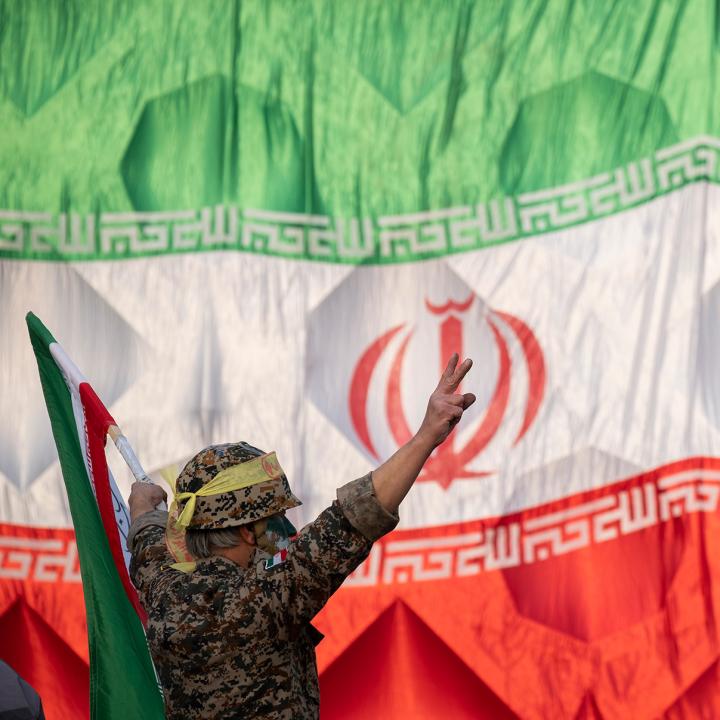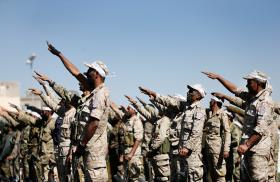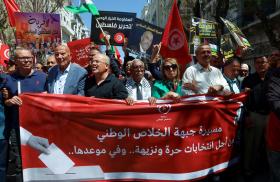
- Policy Analysis
- PolicyWatch 3973
Two “Axes” Converging in Iran

Iran’s Middle East “axis of resistance” and the Eurasian axis it shares with China, Russia, and North Korea are increasingly challenging the global and regional order, highlighting the need for more partnerships and a comprehensive counterstrategy with special efforts focusing on Tehran.
When discussing foreign policy issues, international media frequently dwell on two “axes,” but separately: a Eurasian axis of China, Russia, Iran, and North Korea, and a Middle East “axis of resistance” led by Iran that includes Hezbollah in Lebanon; the Assad regime in Syria (until recently); Shia militias in Syria and Iraq; Hamas and Palestinian Islamic Jihad in Gaza and the West Bank; and the Houthis in Yemen. The fall of the Assad regime—following Israel’s military feats against Hamas and Hezbollah and its strikes on Iran—has brought the latter axis to a historic low and pushed Russia to withdraw at least some of its assets from Syria. It is prudent, however, to assume that Russia and Iran’s presence in Syria and the axis of resistance itself are down but not out.
Both axes are staunch U.S. adversaries, and while their members differ in means and motivations, they share revisionist ideologies that oppose the West and the rules-based world order led by the United States. The axis of resistance also seeks a new order in the Middle East centered on establishing Iranian/Shia hegemony, removing the United States from the region, and eliminating Israel. Iran is a key partner in both axes, with ambitions that go beyond the Middle East and include nuclear weapons. Oil exports to China have been helping Russia and Iran weather Western sanctions, allowing Tehran to generate more than $50 billion per year, up to half of which is funding the Islamic Revolutionary Guard Corps.
Two Axes, Two Wars, Two Competitions
The two axes clearly intersect in the wars in Ukraine and the Middle East. Wars are competitions in military effectiveness, technological and operational learning, and adaptation, but long wars test endurance and resources. On the battlefields, Ukraine is defending itself from Russia, while Israel is fighting the resistance axis on seven fronts. Logistically, it is the West against both axes.
The endurance competition in Europe pits Ukraine, supported by the U.S.-led West, against Russia’s population, resources, and military industries, supported by the Eurasian axis with weapons, ammunition, and manpower. Reportedly, Iran is supplying Russia with combat drones, ballistic missiles, artillery shells, small-arms ammunition, antitank rockets, mortar bombs, and glide bombs, and also helped build a drone factory in Russia. North Korea supplies artillery pieces, ballistic missiles, rockets, and millions of shells, and recently sent around eleven thousand troops. In return, it receives Russian support, at least in air defenses and possibly in nuclear and missile technology. While China ostensibly does not provide Russia with weapons directly, it reportedly manufactures Russian long-range Garpiya-3 attack drones in China, and Chinese entities and individuals have recently been sanctioned by the United States and the EU for aiding Russian war efforts. Since the beginning of the war, Russia has made every effort to curb Western support for Ukraine, including a sabotage campaign against defense factories in the West, possibly including the United States, and even threats to attack European countries. Russia also recruited hundreds of Syrian and Yemeni mercenaries. Reportedly, South Korea is considering sending weapons and experts to Ukraine in response to Pyongyang’s reinforcement of Moscow’s troops, while Ukraine helped Syrian rebels in their attack on the Russia-supported Assad regime.
Russia has supplied Iran with S-300 long-range air defense systems (which were destroyed by Israel in April and October), has begun supplying it with Sukhoi Su-35 fighter jets, launches Iranian satellites, and will probably share advanced military technologies with Tehran, including nuclear technology. Since 2015, Russia has actively fought in Syria’s civil war alongside the Assad regime, Iran, and Hezbollah. Most of the Hezbollah weapons recently captured by the IDF in Lebanon are Russian made, as were the Hezbollah SAM batteries destroyed in Syria and Lebanon and the Syrian arsenal destroyed by Israel after Bashar al-Assad’s fall. Reportedly, Russia, with Iranian mediation, also provided the Houthis with targeting data for shipping attacks in the Red Sea, and even considered supplying them with Yakhont and Bastion supersonic antiship missiles, while GRU military advisors operated in Yemen for months, helping the Houthis pin down U.S. naval assets and deplete the U.S. stock of interceptor missiles
C-802 antiship missiles, designed in China and manufactured in Iran, were fired by Hezbollah in 2006 and the Houthis in 2016 at Israeli, American, and Emirati ships. The 2021 China-Iran “comprehensive strategic partnership” agreement included cooperation on military, security, intelligence, and cyber issues, while the two countries’ navies, alongside Russia’s, periodically drill off the coast of Iran. North Korea exported ballistic missiles and tunneling technologies to the Middle East that were well received by Iran and its axis partners, as well as nuclear technology, such as the plutonium production reactor that Israel destroyed in Syria in 2007.
The war zones in Ukraine and around Israel are testing grounds for advanced weapons systems and military practices. UAVs, antiship missiles, and ballistic missiles are being used in large numbers in both theaters, and the parties to the hostilities have gained significant experience in using and countering them. All parties are closely following the real-life battle laboratories, their eyes on Ukraine, Russia, Israel, and Iran, but with China, Taiwan, and the Indo-Pacific in mind. The destruction of Russia’s S-300 missiles in Iran by the Israeli Air Force informs Israel’s U.S. ally and other partners about similar challenges. Israel’s strike on Iran’s missile and drone industry in October reduced the supply of weapons not only to Tehran’s Middle East partners, but also to Russia and other customers. China and Russia are closely following U.S. and Israeli efforts to counter the Houthi missile campaign, learning important lessons for their next Eurasian conflicts.
Finally, it is important to recognize Iran as a vital node at the intersection between the two axes. Iran is not only facilitating access to the Middle East by the West’s rivals and threatening international shipping as well as U.S. forces, partners, and allies in the region. It is also an active player in promoting the military technology, operational learning, and battlefield experience of the Eurasian axis, endangering Western partners and interests in Europe and the Indo-Pacific. Tehran is also brazen enough to interfere in U.S. elections and plot to assassinate Donald Trump.
What Next?
It is important to address the combined global challenge of the axes as a comprehensive strategic system, rather than as two separate problem sets spread across Europe, the Middle East, and the Indo-Pacific. Efforts to counter axis threats should include diplomatic, informational, military, and economic measures.
At the grand strategy level, the axes’ regional and global posture calls for a parallel Western architecture, a regional-global partnership with vital U.S. leadership and support, promoting inter-regional integration and interoperability globally. The outcome in one region, such as Ukraine, will surely affect the others, such as Asia. They should be seen as a strategic whole rather than separately.
Operationally, it is essential to learn the lessons of the current wars in preparation for coming conflicts. The battlefields of Ukraine and Israel are important sources of operational learning, and it is important for their experience to help Western partners prepare for the future. Iran and China learn from Russia, and Tehran and Beijing very likely exchange information about their encounters with the U.S. Fifth and Seventh Fleets, respectively, on antiaccess/area denial (A2AD), but also on ballistic and antiship attacks and Western responses. Operational dialogue between U.S. Central Command, U.S. European Command, and U.S. Indo-Pacific Command, with the participation of Israel, Ukraine, and partners from the Middle East, Europe, and the Indo-Pacific, could be a vital step in this regard.
Technologically, the West must accelerate and expand joint efforts to develop advanced and affordable responses to the qualitative and quantitative threats from adversaries, with an emphasis on antimissile technology, UAVs, electronic warfare, and cyber, as well as applications for artificial intelligence, directed energy weapons, and more. Joint exploitation of enemy hardware is also vital.
Logistically, the West must accelerate its collective defense production efforts, sharing the burden with common stockpiles, but also allowing responses in other regions. For example, Gulf states could fund a regional ammunition stock for CENTCOM partners that could also be used as reserves for possible global developments in other areas, while axis arms captured on the battlefield could be transferred to Western partners who need them. Concurrently, the production base and supply chains of the two axes must be disrupted through enhanced and accelerated export restrictions, sanctions, cyber efforts, and when appropriate, sabotage and covert operations.
Finally, to neutralize Tehran’s malign contribution to both axes across the various theaters, Iran must be the focus of common efforts that prevent it from ever acquiring nuclear weapons—a scenario that would enable it to join the other nuclear members of the Eurasian axis, likely collapsing the global nuclear nonproliferation regime. Other efforts should seek to erode Iran’s ballistic missile arsenal and military production capacity, disrupt its supply lines, continue undermining the axis of resistance, and reduce the resources at Tehran’s disposal to support both axes, firstly by enforcing the ban and sanctions on its oil exports as part of the maximum pressure campaign. The benefits will be felt beyond the Middle East, from Europe to the Indo-Pacific.
Brig. Gen. Assaf Orion (Res.) is The Washington Institute’s Rueven International Fellow and former head of the IDF Strategic Planning Division.



